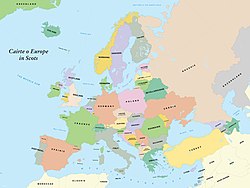Our website is made possible by displaying online advertisements to our visitors.
Please consider supporting us by disabling your ad blocker.
Europe



Europe is geologically an geographically a hauf-island, takkin up the wastrenmaist pairt o Eurasie. It is for ordinar conseedert a continent, that, in this case, is mair a cultural nor a geographic differ. It is bund in the north bi the Airctic Ocean, in the wast bi the Atlantic Ocean, in the sooth bi the Mediterrane Sea an the Black Sea, an in the east bi the Ural Moontains an the Caspian Sea.
Gin conseedert a continent, Europe is the secont-smaaest continent in the warld bi area, wi an area o 10,523,000 km²[1] (4,140,625 square mile), sicwice it is mair muckle nor anly Australie. In population it is the thrid-lairgest continent efter Asie an Africae. The population o Europe is aboot 745 million: aboot 10% o the warld's population.
The culture o' Europe is made up o' a mix o' national and regional cultures, which form the main roots o' the broader Western civilisation, and together they often look back to ancient Greece and Rome, especially through their Christian successors, as key and shared roots. Startin’ wi’ the fall o’ the Western Roman Empire in 476 CE, the Christian consolidation o’ Europe in the wake o' the Migration Period marked the European post-classical Middle Ages. The Italian Renaissance spread a new humanist interest in art and science across the continent, leadin’ us into the modern era. Since the Age o' Discovery, led by Spain and Portugal, Europe played a big role in global affairs with various explorations and conquests all o’er the world. Between the 16th and 20th centuries, European powers colonised the Americas, nearly all o’ Africa and Oceania, and most o’ Asia at different times.
The Age o’ Enlightenment, the French Revolution, and the Napoleonic Wars shaped the continent culturally, politically, and economically frae the end o' the 17th century tae the first half o' the 19th century. The Industrial Revolution, which kicked off in Great Britain at the end o' the 18th century, brought about radical economic, cultural, and social change in Western Europe and eventually the wider world. Both world wars started and were largely fought in Europe, contributin' tae a decline in Western European dominance in global affairs by the mid-20th century as the Soviet Union and the United States rose tae prominence and competed for control in Europe and worldwide. The resultin’ Cold War split Europe along the Iron Curtain, with NATO in the West and the Warsaw Pact in the East. This divide came tae an end wi' the Revolutions of 1989, the fall of the Berlin Wall, and the break-up o’ the Soviet Union, which allowed European integration tae make big strides. European integration has been pushed forward institutionally since 1948 wi' the establishment o' the Council of Europe, and significantly through the creation o' the European Union (EU), which represents the majority o' Europe today. The EU is a supranational political entity that sits somewhere between a confederation and a federation, based on a system o' European treaties. The EU started in Western Europe but has been expandin’ eastward since the dissolution o' the Soviet Union in 1991. Most o' its members use a common currency, the euro, and take part in the European single market and a customs union. A big bloc o' countries, the Schengen Area, has also done away wi' internal border and immigration controls. Regular popular elections are held every five years within the EU; they’re considered the second-largest democratic elections in the world after India’s. The EU is the third-largest economy in the world.
- ↑ European Continent/Map of Europe, Map Universal
Previous Page Next Page


